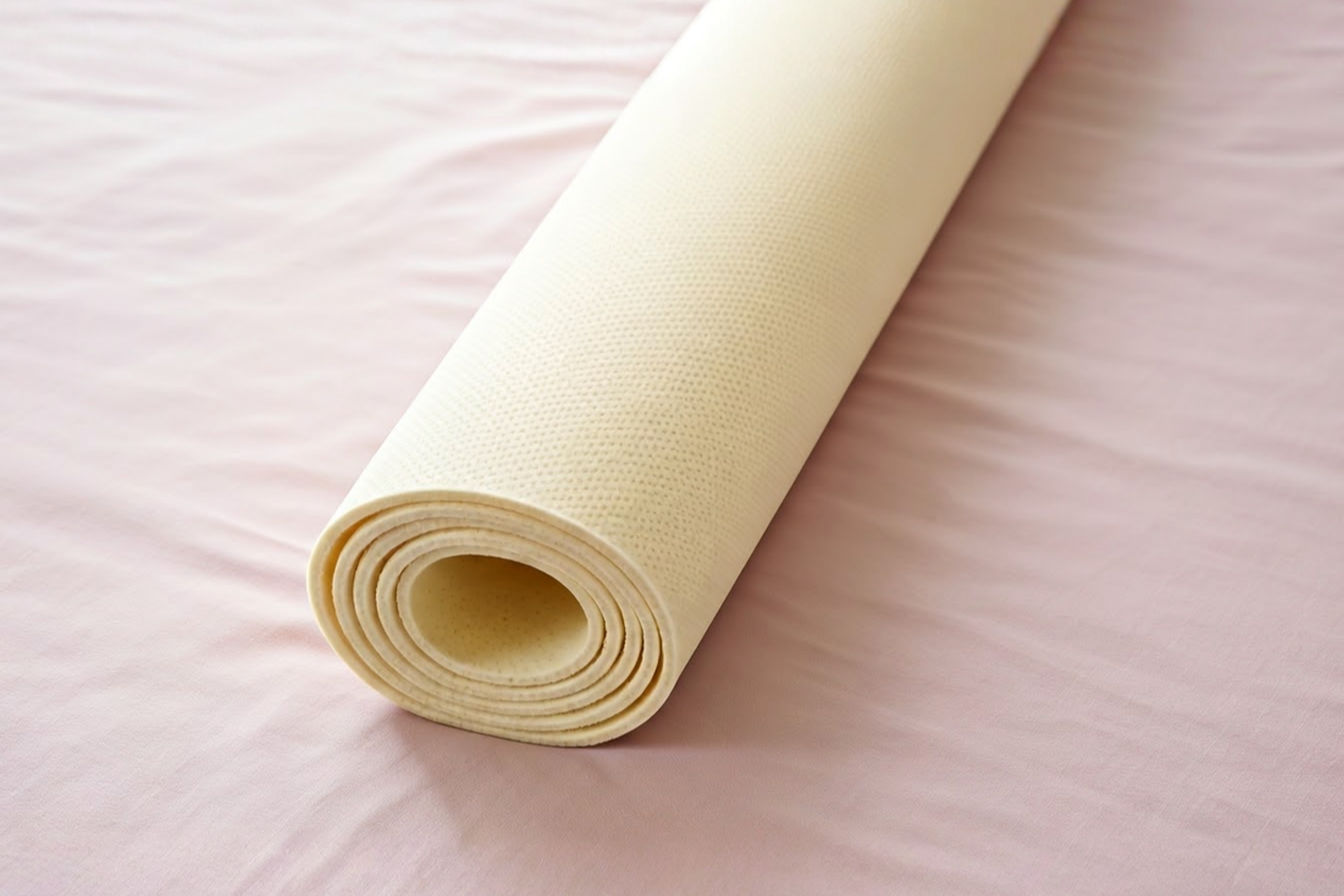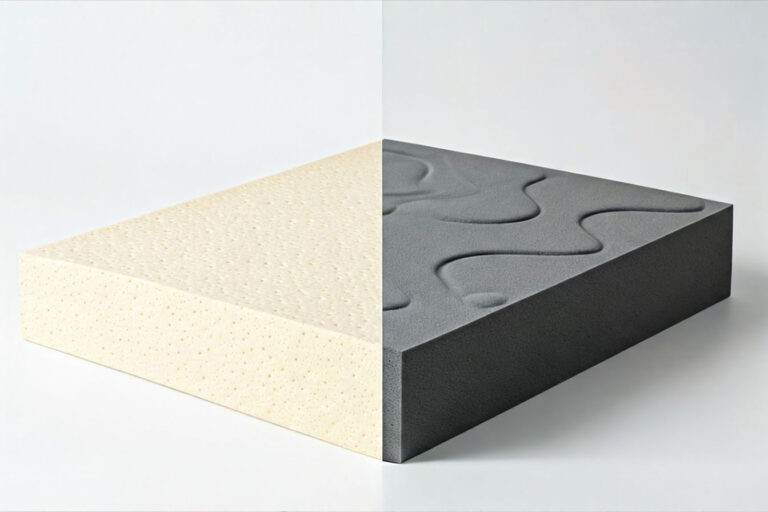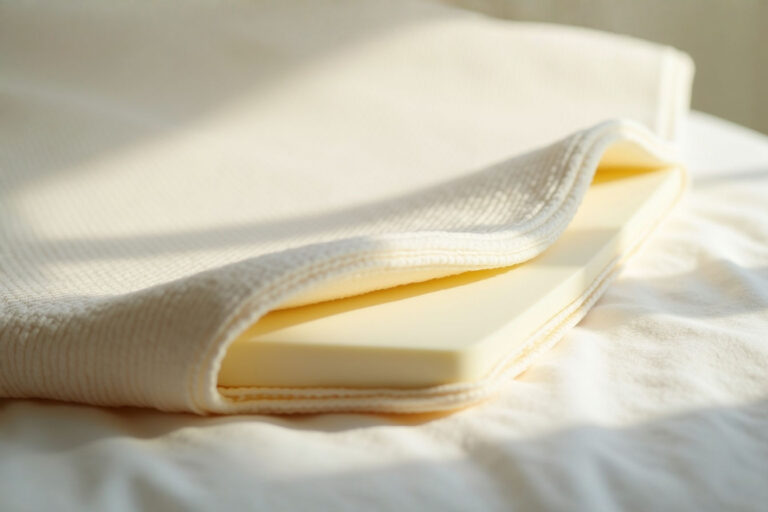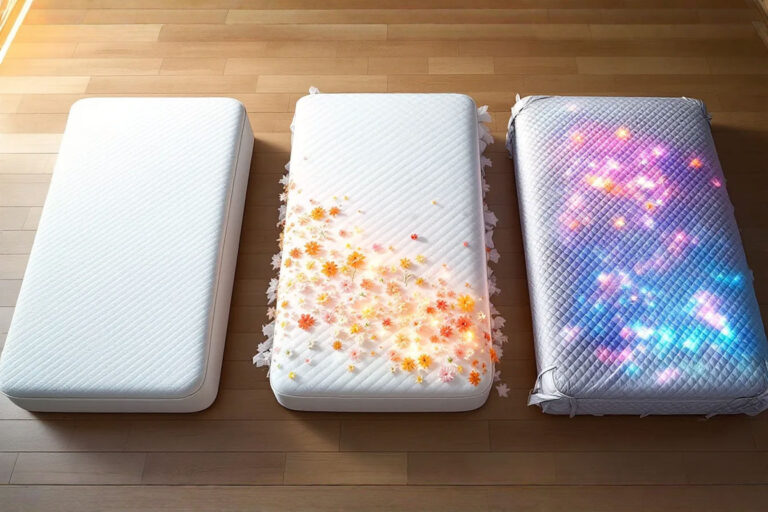Latex Bed Topper: The 7-Year Investment That Outlasts Memory Foam by 4 Years
Natural latex bed toppers last 7+ years compared to memory foam’s 3-5 year lifespan. Discover if this durable, eco-friendly sleep investment delivers the long-term value you need.

When it comes to improving your sleep quality, most people think about buying a new mattress. Yet a quality mattress topper often provides the perfect solution at a fraction of the cost. However, not all toppers are created equal, especially when it comes to longevity. While the average memory foam topper starts to lose its supportive properties after just 3 years, natural latex toppers maintain their performance for 7 years or more – making them a superior long-term investment.
This impressive durability gap represents more than just a few extra months of comfort; it’s an additional 4 years of restful sleep without replacement costs. The secret lies in latex’s naturally resilient structure, which continues to provide consistent support long after memory foam has begun to sag and compress.
Latex offers a unique combination of comfort, support, and eco-friendly materials that set it apart from petroleum-based alternatives. Harvested from rubber trees, natural latex brings sustainable credibility while delivering exceptional durability that memory foam simply cannot match.
Throughout this guide, we’ll explore why latex toppers substantially outlast their memory foam counterparts, the different types available, maintenance strategies to maximize their lifespan, and how to determine if this longer-lasting sleep solution represents the right investment for your specific needs.
What Are Latex Bed Toppers?
A latex bed topper is a layer of cushioning material made from either natural or synthetic latex that sits on top of your mattress to enhance comfort, support, and overall sleep quality. Natural latex is derived from the sap of rubber trees (Hevea brasiliensis), which is harvested through a sustainable tapping process that allows trees to continue producing for decades. This milky substance is then processed and transformed into the resilient, supportive material used in premium bedding products.
Most latex toppers range from 1 to 3 inches in thickness, with 2 inches being the most popular option for balancing added comfort with proper support. The material naturally comes in multiple firmness levels, typically categorized as soft (ILD 19-21), medium (ILD 24-26), and firm (ILD 29-31), where ILD (Indentation Load Deflection) measures how much weight is needed to compress the latex by 25%.
Price-wise, latex toppers generally command a premium compared to other materials. While a quality memory foam topper might cost between $100-$250, latex options typically range from $200-$500 depending on thickness, certifications, and manufacturing process. This higher initial investment reflects the superior materials and extended lifespan.
The manufacturing process significantly influences the final product’s characteristics. The traditional Dunlop method creates a denser, more supportive product, while the newer Talalay process produces a lighter, more consistently textured topper with enhanced breathability. Both processes impact not only comfort but also the durability that makes latex toppers a standout long-term investment.
Latex vs Memory Foam: A Durability Showdown
When investing in bedding products, longevity stands as a crucial factor – and this is where latex dramatically outperforms memory foam. Natural latex toppers typically maintain their structural integrity and supportive qualities for 7-10 years, whereas memory foam toppers generally begin to deteriorate after just 3-5 years of regular use.
This remarkable durability difference stems from fundamental structural variations between the materials. Latex consists of a network of interconnected natural rubber cells that possess inherent elasticity and resilience. This cellular structure allows latex to consistently return to its original shape even after years of compression. Memory foam, conversely, relies on polyurethane cells filled with air pockets that gradually break down under consistent pressure, causing permanent compression and reduced support.
The degradation process differs significantly between these materials. Memory foam toppers begin breaking down relatively quickly, with most users noticing visible body impressions and diminished support around the 3-year mark. The polyurethane structure gradually loses its ability to “bounce back,” particularly in high-pressure areas like shoulders and hips. Meanwhile, latex maintains its responsive properties much longer, with minimal sagging even after 5+ years of nightly use.
Performance evolution over time reveals another stark contrast. Memory foam typically softens considerably as it ages, providing progressively less support and pressure relief. This softening accelerates in warmer environments and with heavier sleepers. Latex, however, exhibits remarkable consistency throughout its lifespan, with minimal changes in firmness or support characteristics – a key factor for those seeking long-term spinal alignment and comfort.
Real-world variables significantly impact these durability differences. Heavier individuals place greater strain on foam materials, causing memory foam to deteriorate faster while latex maintains its integrity. Similarly, temperature fluctuations affect memory foam more dramatically, with hot sleepers often reporting accelerated breakdown compared to the temperature-neutral performance of latex.
Types of Latex Toppers and Their Durability
Not all latex toppers offer identical durability, as the specific type directly influences longevity. Understanding these variations helps consumers make the most cost-effective long-term choice.
Natural latex, harvested directly from rubber trees, represents the gold standard for durability. These premium toppers consistently deliver 7-10+ years of supportive comfort without significant degradation. The natural rubber compound maintains its essential elastic properties through thousands of compression cycles, resulting in an exceptionally long-lasting product. This impressive longevity comes from the material’s inherent molecular structure, which features superior tensile strength and resilience compared to synthetic alternatives.
Synthetic latex toppers, created from petroleum-based compounds (styrene-butadiene rubber), offer moderate durability ranging from 5-7 years. While engineered to mimic natural latex’s properties, these synthetic versions lack the same molecular composition that provides natural latex’s exceptional resilience. Consequently, they typically show signs of compression and performance loss earlier, particularly in high-pressure areas.
Blended latex combines both natural and synthetic materials in various ratios (commonly 70% synthetic/30% natural or 60%/40%). Their durability falls between the two pure versions, generally lasting 6-8 years depending on the specific blend ratio. Higher percentages of natural latex correlate with improved longevity.
Organic certification significantly impacts both quality and lifespan. Toppers certified by organizations like GOLS (Global Organic Latex Standard) must meet stringent processing requirements that preserve the material’s natural resilience. These certified products typically offer the highest durability among all latex options, often exceeding 10 years with proper care. The absence of chemical additives that can degrade rubber compounds contributes to this extended performance life.
For optimal long-term value, 100% natural latex toppers, particularly those with organic certification, provide the best return on investment despite higher initial costs. When calculating price-per-year of comfortable use, natural latex consistently outperforms both synthetic variants and competing materials like memory foam.
Manufacturing Processes: Dunlop vs Talalay
The manufacturing method employed to create latex toppers significantly influences their durability characteristics, with two predominant processes dominating the market: Dunlop and Talalay.
The Dunlop process, developed in 1929, remains the traditional and more straightforward manufacturing method. Liquid latex sap is whipped into a froth, poured into molds, covered, and steam-baked. This simpler process creates a sediment layer at the bottom, resulting in a denser, heavier final product. The bottom portion contains more natural rubber, while the top maintains a somewhat lighter feel. This density gradient makes Dunlop latex exceptionally durable, particularly in supporting heavier individuals over extended periods without compression.
In contrast, the Talalay process, developed later in the 1940s, involves additional steps. After the mold is partially filled with latex foam, a vacuum seals the mold, expanding the latex to fill the entire space. The material is then flash-frozen to stabilize the cell structure before baking. This creates a more homogeneous internal structure with consistent density throughout. While slightly less dense than Dunlop latex, Talalay produces a more consistently supportive surface with superior breathability.
Durability comparisons reveal that Dunlop latex typically edges out Talalay in pure longevity, often lasting 8-10+ years compared to Talalay’s 7-9 years. This advantage stems from Dunlop’s denser composition, which offers greater resistance to compression over time. However, Talalay maintains its specific feel characteristics more consistently throughout its lifespan, providing more reliable comfort properties year after year.
The manufacturing complexity creates notable price differences, with Talalay latex products commanding a 20-30% premium over comparable Dunlop options due to the more resource-intensive production process. Despite this higher cost, some sleepers prefer the consistent feel and enhanced breathability of Talalay, particularly those who sleep hot or require precise pressure relief.
For maximum longevity, Dunlop latex typically represents the better investment, especially for heavier individuals or those prioritizing support over plushness. However, both processes create remarkably durable products that substantially outlast memory foam alternatives.
7 Key Benefits of Investing in a Latex Topper
Beyond its impressive longevity, latex toppers offer numerous additional advantages that justify their position as premium bedding investments.
- Exceptional durability translates to superior value. With a lifespan more than double that of memory foam (7+ years versus 3-5 years), latex toppers ultimately cost less per year of use despite their higher initial price point. This extended performance eliminates the frustration and expense of frequent replacements.
- Consistent support throughout years of use sets latex apart from alternatives. Unlike memory foam, which progressively softens and develops body impressions, latex maintains its original firmness and supportive characteristics with minimal change. This consistency proves crucial for sleepers with specific support needs, particularly those managing back pain or seeking precise spinal alignment.
- Natural resistance to common sleep contaminants enhances both longevity and health benefits. Latex’s inherent antimicrobial and anti-fungal properties naturally resist dust mites, mold, and bacteria without chemical treatments. These properties remain effective throughout the topper’s entire lifespan, creating a consistently cleaner sleep surface for allergy sufferers and health-conscious individuals.
- Superior temperature regulation addresses a common complaint with foam toppers. Latex’s open-cell structure allows significant airflow compared to the heat-trapping characteristics of memory foam. This natural breathability facilitates better temperature neutrality year-round, preventing the uncomfortable heat buildup that often disrupts sleep on synthetic materials.
- Immediate responsiveness enhances pressure relief without sacrificing mobility. Unlike memory foam’s slow conforming properties, latex instantly adapts to movement while still providing excellent pressure point relief. This responsive nature maintains proper spinal alignment while eliminating the “stuck” feeling many experience with slower-responding foam products.
- Effective motion isolation proves beneficial for couples. Natural latex absorbs movement efficiently, minimizing sleep disruption when partners shift position or get in and out of bed. This isolation capability remains consistent throughout the material’s lifespan, unlike memory foam which often loses this property as it softens.
- Eco-friendly credentials satisfy increasing consumer demand for sustainable products. Natural latex toppers, particularly certified organic options, represent a renewable resource harvested from rubber trees without harming the plant. Additionally, natural latex remains biodegradable at the end of its useful life, unlike petroleum-based alternatives that persist in landfills for decades.
This comprehensive set of benefits, maintained throughout latex’s extended lifespan, creates exceptional long-term value that memory foam and other topper materials simply cannot match.
Factors That Extend Your Latex Topper’s Lifespan
While latex naturally outlasts other topper materials, several key factors can further extend its useful life beyond the standard 7-year expectation.
Proper foundation support plays a critical role in preserving latex integrity. Using your topper on an uneven or sagging mattress accelerates wear by creating pressure points and uneven compression. An ideal base provides consistent, firm support across the entire surface, whether from a newer mattress, platform bed, or properly maintained box spring. Slat systems should feature gaps no wider than 3 inches to prevent latex from stretching between supports.
Protective covers specifically designed for latex significantly extend longevity. A quality waterproof yet breathable protector shields against spills, body oils, and dust while allowing proper air circulation. Look for organic cotton covers with thin waterproof membranes that preserve latex’s natural breathability while providing essential protection from contaminants that degrade the material.
Regular rotation proves particularly effective for extending wear patterns. Unlike memory foam, latex toppers respond well to quarterly rotation (head-to-foot), which redistributes compression forces and prevents localized wear. Some thinner latex toppers can even be flipped occasionally, further extending their useful lifespan by utilizing both surfaces.
Weight distribution considerations significantly impact durability. Couples with substantial weight differences should consider regularly switching sides of the bed to prevent uneven compression. Similarly, those using only one side of a larger topper should periodically rotate their sleeping position to distribute wear more evenly across the surface.
Environmental factors also influence longevity. Latex performs optimally and lasts longest in moderate temperature and humidity conditions (65-75°F, 40-60% humidity). Excessive heat or dampness can accelerate material breakdown, while extremely dry conditions may cause natural latex to become less supple over time. Using appropriate bedding layers helps moderate these environmental variables.
Proper handling during moves or storage prevents structural damage. Always transport latex toppers flat rather than folded, as creases can become permanent if maintained for extended periods. If storage becomes necessary, maintain the topper in a flat position, protected from direct sunlight and extreme temperatures.
Essential Maintenance for a 7+ Year Lifespan
Maintaining a latex topper properly requires minimal but specific care routines that significantly extend its useful life beyond average expectations.
Regular cleaning prevents accumulation of contaminants that can degrade latex over time. For routine maintenance, vacuum the topper surface monthly using a handheld vacuum with upholstery attachment on low suction. This removes dust and allergens without stressing the material. The process takes just minutes but substantially preserves latex integrity by preventing particle buildup that can abrade the cellular structure.
Addressing spills promptly prevents liquid penetration that can compromise latex. Blot (never rub) any spills immediately with clean, absorbent cloth. For deeper cleaning, spot clean with mild soap and warm water, applying minimal moisture and allowing complete air drying before recovering. Avoid harsh detergents, bleach, or commercial cleaners that can break down latex’s natural structure.
Periodic airing refreshes latex and removes accumulated moisture that could foster bacterial growth. Twice yearly, remove all coverings and allow the topper to breathe in indirect sunlight for 2-3 hours. This process not only eliminates moisture but also naturally deodorizes the material and restores some of its resilience. However, avoid prolonged direct sunlight exposure, which can degrade latex through UV damage.
For seasonal storage or extended non-use periods, proper techniques prevent permanent damage. Always store latex toppers flat rather than folded or rolled, ideally on a spare bed or flat surface. If space constraints require rolling, use the largest diameter possible to minimize stress on the material. Cover with breathable cotton rather than plastic to prevent moisture accumulation while protecting from dust.
Regular inspection helps identify maintenance needs before they affect performance. Check quarterly for signs of uneven compression, discoloration, or unusual odors that might indicate cleaning requirements. Address any issues immediately to prevent progressive deterioration that could shorten the topper’s useful life.
With these simple maintenance practices, a quality latex topper can reliably provide comfort and support well beyond the average 7-year expectation, making it an even more valuable long-term investment.
Who Benefits Most From a Latex Topper Investment?
While latex toppers offer advantages for most sleepers, certain individuals will realize particularly significant benefits from this long-term bedding investment.
Side sleepers experience exceptional pressure relief with lasting performance. The shoulders and hips create intense pressure points in this position, areas where memory foam often develops premature compression. Latex’s resilient support maintains proper alignment at these critical points year after year, preventing the gradual deterioration in pressure relief that occurs with synthetic alternatives. This consistent performance proves especially valuable for dedicated side sleepers seeking long-term comfort.
Individuals with back pain or joint issues benefit substantially from latex’s consistent support characteristics. Unlike memory foam, which progressively softens and loses supportive properties, latex maintains its prescribed firmness level throughout its extended lifespan. This consistency proves crucial for those requiring specific support profiles to manage chronic pain conditions, eliminating the need for frequent replacements as support diminishes.
Hot sleepers find particular value in latex’s superior breathability compared to memory foam. The natural open-cell structure promotes significantly better airflow, addressing a primary complaint about foam products. This temperature advantage remains consistent throughout latex’s entire lifespan, unlike memory foam which often becomes even less breathable as it ages and compresses.
Eco-conscious consumers appreciate latex’s sustainable harvesting and biodegradable nature. Natural latex represents one of the few truly renewable bedding materials, particularly when certified organic. The extended lifespan further enhances environmental benefits by reducing replacement frequency and associated manufacturing impacts.
Those with allergies or respiratory sensitivities benefit from latex’s natural resistance to dust mites, mold, and mildew. These hypoallergenic properties remain effective throughout the material’s lifespan without requiring chemical treatments that can off-gas or diminish over time. For many allergy sufferers, this consistent protection justifies the premium investment.
Value-focused shoppers recognize latex’s superior long-term economics despite higher initial costs. When calculating cost-per-year based on typical lifespans, quality latex toppers often outperform budget alternatives by a significant margin. This value proposition particularly appeals to those willing to invest upfront for reduced long-term expenses and consistent performance.
For these sleeper categories, latex toppers represent not just a purchase but a strategic investment in sustained comfort, health, and economic value.
Environmental and Health Considerations
The environmental and health aspects of latex toppers further distinguish them from synthetic alternatives, offering additional value beyond pure durability.
Natural latex stands as one of the few truly biodegradable bedding materials available in today’s market. At the end of its useful life, a natural latex topper will decompose in landfill conditions within 5-10 years, compared to the 50-100+ years required for petroleum-based memory foam. This biodegradability significantly reduces long-term environmental impact, particularly when considering the multiple memory foam replacements that would occur during a single latex topper’s lifespan.
Carbon footprint comparisons reveal substantial differences between materials. Memory foam production relies heavily on petroleum extraction and energy-intensive manufacturing processes that generate significant greenhouse gas emissions. Natural latex harvesting, conversely, actually creates a carbon-positive impact as rubber trees sequester carbon dioxide throughout their productive lives. Even accounting for processing and shipping, natural latex’s overall carbon footprint measures 25-30% lower than comparable memory foam products.
Sustainable harvesting practices further enhance latex’s environmental credentials. Properly managed rubber plantations tap trees without harming them, allowing continued production for 25+ years. This regenerative approach supports biodiversity and prevents deforestation while providing sustainable livelihoods for agricultural communities. Leading producers now implement cultivation methods that eliminate the need for pesticides or synthetic fertilizers, further reducing environmental impact.
Certification standards help consumers identify truly sustainable options. Look for GOLS (Global Organic Latex Standard) certification, which ensures both organic cultivation and responsible processing. Other relevant certifications include GOTS (for organic cotton covers), Oeko-Tex Standard 100 (verifying the absence of harmful substances), and Rainforest Alliance (confirming sustainable harvesting practices).
Regarding latex allergies, most concerns prove greatly exaggerated for quality toppers. The extensive washing during manufacturing removes the specific proteins responsible for latex allergies. Additionally, encasing the topper in a protective cover eliminates direct contact. Studies show that less than 1% of people with diagnosed latex allergies react to properly processed bedding latex, which differs significantly from the medical-grade material that typically triggers reactions.
These environmental and health advantages create additional long-term value that extends beyond the already impressive durability advantage that latex holds over synthetic alternatives.
Selecting the Right Latex Topper for Maximum Longevity
Choosing the optimal latex topper requires careful consideration of several key factors to ensure maximum durability and performance for your specific needs.
Thickness selection significantly impacts both comfort and longevity. For extending a moderately worn mattress’s life, a 2-3 inch topper provides ideal support without excessive pressure. However, when rejuvenating a significantly compressed mattress, 3 inches offers necessary depth to prevent “bottoming out.” Thinner 1-inch options generally provide insufficient depth for proper pressure distribution, leading to faster compression in high-pressure areas. For maximum durability, 2-3 inches represents the sweet spot balancing support with resilience.
Firmness requires careful matching to both sleep position and body weight. Side sleepers typically achieve optimal longevity with medium firmness (ILD 24-26), which provides necessary pressure relief without excessive softness that could lead to premature compression. Back and stomach sleepers generally benefit from medium-firm to firm options (ILD 28-32) that maintain proper spinal alignment year after year. Heavier individuals (200+ pounds) should select firmer ratings within their position’s recommended range to ensure consistent support throughout the topper’s lifespan.
Material composition directly correlates with durability expectations. For maximum longevity, choose 100% natural latex rather than synthetic or blended options. While this selection commands a premium (typically 30-40% higher), the additional 2-3 years of useful life justifies the investment. Within natural latex options, those with higher rubber content (indicated by greater density) typically deliver superior resistance to compression over time.
Certifications serve as reliable indicators of quality and durability. Products certified to GOLS standards must meet strict criteria for purity and processing that directly enhance longevity. Similarly, toppers carrying extended warranties (7+ years) reflect manufacturer confidence in durability. Be wary of products lacking specific latex type details or offering unusually short warranty coverage, as these often indicate lower-quality materials that will degrade more quickly.
Construction details reveal much about expected lifespan. Examine seam quality, cover materials, and overall finishing. Continuous latex sheets generally outlast glued sections or shredded latex constructions. Similarly, removable covers with quality zippers allow for easier maintenance that extends overall performance life. These seemingly minor details significantly impact durability over the long term.
When purchasing, ask specific questions about density ratings, rubber percentage, and manufacturing location. Higher density correlates directly with improved longevity, while manufacturing in established latex-producing regions often indicates greater expertise and quality control that enhances durability.
Cost Analysis: The True Value of a 7-Year Investment
Understanding the complete economic picture reveals why latex toppers represent superior long-term value despite higher initial prices.
Initial investment for quality latex toppers typically ranges from $200-$500 depending on size, thickness, and certifications. This represents a substantial premium compared to entry-level memory foam alternatives priced at $100-$250. However, this price comparison alone fails to capture the true economic equation at play over the respective lifespans of these products.
Replacement frequency creates dramatic differences in total ownership costs. With memory foam requiring replacement every 3-5 years, a 10-year period typically necessitates 2-3 purchases. In contrast, a single quality latex topper usually provides consistent performance throughout this entire decade. This replacement differential significantly alters the total investment required.
Calculating annual cost reveals the true value proposition. A $300 latex topper lasting 7 years represents approximately $43 per year of use. Meanwhile, a $150 memory foam option requiring replacement after 4 years costs about $37.50 annually. This modest $5.50 annual difference delivers substantially better performance along with eliminating the hassle of more frequent research, purchase, and replacement cycles.
Real-world comparative scenarios illustrate this economic advantage clearly. Consider a queen-size bed over 10 years: purchasing a $400 natural latex topper provides entire-decade coverage at $40 annually. Alternatively, selecting a $200 memory foam option replaced twice during this period raises the total investment to $600 ($60 annually) while delivering inferior average performance as each topper degrades before replacement.
The economic advantage becomes even more pronounced when factoring performance consistency. Memory foam’s gradual deterioration means users experience suboptimal support for significant portions of each product’s lifespan. Latex maintains consistent performance characteristics, providing full value throughout its extended life rather than a declining comfort curve necessitating earlier than ideal replacement.
Quality of life benefits further enhance latex’s value proposition. Reduced shopping frequency, consistent sleep quality, and superior support all represent intangible but meaningful advantages beyond pure pricing considerations. For many consumers, these quality-of-life factors justify the modest premium even before calculating the favorable long-term economics.
When viewed through this comprehensive cost lens, latex toppers clearly represent the superior economic choice for value-conscious consumers focused on long-term investment rather than merely minimizing initial purchase price.
Common Myths and Misconceptions About Latex Toppers
Several persistent myths surrounding latex toppers often prevent consumers from considering this durable option. Addressing these misconceptions reveals additional advantages of these long-lasting sleep products.
Myth: “All latex toppers feel too firm or bouncy.” Reality: Modern latex toppers come in multiple firmness levels ranging from quite plush (ILD 19-21) to supportively firm (ILD 29-31). While latex does provide more immediate response than memory foam’s slow sink, many sleepers actually prefer this balanced feel that prevents the “quicksand sensation” some experience with foam. Talalay latex in particular can provide exceptional softness while maintaining proper support. The diversity of options ensures most sleepers can find a comfortable latex configuration.
Myth: “Latex toppers aren’t suitable for people with latex allergies.” Reality: The specific proteins that trigger latex allergies are primarily found in liquid latex and medical products like gloves. Quality bedding latex undergoes multiple washing cycles during manufacturing that remove these allergens. Additionally, all latex toppers come encased in covers that eliminate direct contact. Studies consistently show that less than 1% of individuals with confirmed latex allergies react to properly manufactured bedding products. Most manufacturers now offer trial periods that allow concerned individuals to test compatibility risk-free.
Myth: “Latex toppers are too expensive to be worth consideration.” Reality: While latex does command a higher initial price, the total cost of ownership over 7+ years makes it the more economical option compared to replacing lower-quality alternatives multiple times. When calculated on an annual basis, latex often proves less expensive than memory foam while delivering superior performance throughout its extended lifespan. This value equation improves further when considering the consistent comfort provided versus the gradual deterioration experienced with synthetic alternatives.
Myth: “Natural latex doesn’t last any longer than synthetic versions.” Reality: Extensive testing and real-world experience consistently demonstrate that 100% natural latex maintains its supportive properties 25-30% longer than synthetic or blended alternatives. This durability difference stems from the superior molecular structure of natural rubber, which maintains elasticity through thousands more compression cycles than petroleum-based substitutes. This performance gap becomes particularly evident after the 5-year mark, when synthetic options typically show significant degradation while natural latex continues performing consistently.
Myth: “Latex toppers trap heat just like memory foam.” Reality: Latex’s open-cell structure naturally allows significantly better airflow compared to the dense composition of memory foam. This structural difference creates superior temperature neutrality, with testing showing latex toppers average 3-5°F cooler than comparable memory foam surfaces throughout the night. Many latex options now incorporate additional ventilation channels that further enhance this natural breathability advantage.
By dispelling these common misconceptions, consumers can make more informed decisions about whether a latex topper’s exceptional durability and performance characteristics align with their specific sleep needs and value priorities.
Conclusion: Is a Latex Topper the Right 7-Year Investment for You?
After exploring the exceptional durability and comprehensive benefits of latex toppers, the central question remains: does this longer-lasting investment align with your specific needs and priorities?
The longevity advantage latex holds over memory foam stands uncontested. With a typical lifespan of 7+ years compared to memory foam’s 3-5 years, latex toppers provide consistent performance for nearly twice as long as their synthetic counterparts. This durability translates directly into superior long-term value despite higher initial costs, particularly for those who prioritize sustained comfort without frequent replacements.
Latex delivers its greatest value for specific sleeper profiles. Side sleepers seeking pressure relief without premature compression, those with temperature regulation concerns, individuals requiring precise support for back pain management, and environmentally conscious consumers all realize exceptional benefits from latex’s unique properties. If you belong to these groups, the investment likely represents an ideal match for your specific requirements.
Viewing bedding as a genuine investment rather than a disposable purchase transforms the decision calculus. Quality sleep directly impacts health, productivity, and daily comfort – areas where compromising for minor short-term savings often proves counterproductive. Latex’s consistent performance throughout its extended lifespan ensures you experience its full benefits year after year, unlike alternatives that gradually degrade.
Consider honestly evaluating your personal sleep needs against latex’s distinct advantages. If durability, consistent support, temperature neutrality, or environmental concerns rank highly among your priorities, this natural material likely represents your optimal choice. The additional investment amortized over latex’s extended lifespan delivers exceptional returns in both economic value and sleep quality.
Ultimately, latex toppers represent one of the rare products where premium quality truly delivers tangible long-term advantages – making them a worthwhile consideration for anyone seeking the ideal balance of comfort, performance, and investment value in their sleep environment.






